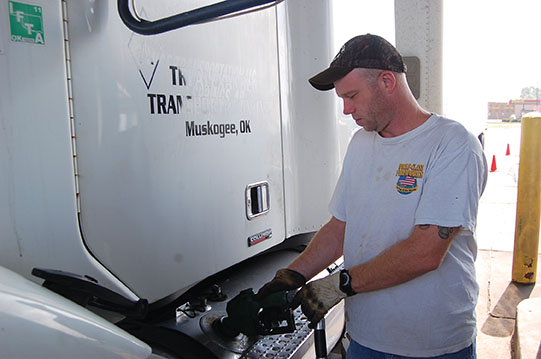Fuel prices are down. Way down. That’s good, right?
The price war waged by Russia and Saudi Arabia, coupled with worldwide bans on air travel and reduced shipping due to manufacturing shutdowns, has resulted in a steep drop in demand for petroleum products. The resulting glut of crude oil on the market depressed market prices to levels rarely seen since the early 1970s. Since the 1970s, only once, between November 1998 and January 1999, did the barrel price for crude drop below $20. Until COVID-19.
When crude prices bottomed out in 1998 and 1999, trucking enjoyed national average diesel fuel prices below $1 per gallon, according to the U.S. Energy Information Administration. This time around, $2.39 was as good as it got nationally, with the lowest recorded price being $2.17 per gallon in the Gulf Coast region.
With prices this low, it’s tempting to forget about all those fuel-conservation habits. Going few more miles per hour saves a little time, and idling, where legal, isn’t a problem, either, right?
Unfortunately, freight rates have fallen faster than diesel prices. Spot market rates have dropped far enough to spark a three-week protest in Washington, D.C., and other shorter events in cities around the country. Some drivers have parked their trucks, waiting for rates to come back up to a level that permits them to at least break even.
Those low diesel prices have another consequence. As fuel prices fall, so do fuel surcharge payments. In some cases, they’ve fallen to zero.
For owner-operators who are leased to a carrier at a set rate per mile, low diesel prices can be a windfall they don’t often see, if they aren’t negated by fuel surcharge losses. For those paid by load-revenue percentage and those running under their own authority, cheap fuel is about the only positive news in a negative market.
Still, fuel is very likely to be the greatest expense of an owner-operator’s business. A trucker that runs 10,000 miles per month (that’s 120,000 miles per year) and averages 6 miles per gallon of fuel will burn 20,000 gallons in a year’s time. At the current low national average of $2.39 per gallon, that’s still a whopping $47,800 per year in fuel cost.
An increase in fuel efficiency of one-half mile per gallon lowers annual fuel consumption to 18,462 gallons. That’s 1,538 gallons of diesel someone doesn’t have to buy, and $3,676 that isn’t spent. That’s a set of tires with some change left over, or maybe a truck payment or two.
Another way to look at cost savings is on a per-mile basis. A gallon of diesel fuel, at $2.39 and 6 miles per gallon, yields a fuel cost of $0.398 per mile. Increasing fuel mileage to 6.5 miles per gallon drops the fuel cost per mile to $0.368, saving three cents a mile. Lowering operating cost by three cents a mile provides a little more leeway on loads, and that can that can be profitable — very important when freight rates are at rock bottom.
Many drivers can improve fuel mileage by .5 mile per gallon simply by adjusting their driving habits. Driving a little slower, minimizing time spent idling and using cruise control are helpful. Maintaining a proper following distance helps minimize how often the brakes are applied followed using the throttle to gain back speed.
There are products on the market that help increase fuel efficiency, too. Wheel covers, flow-through mudflaps, and aerodynamic devices for wheels, according to manufacturers, are enough to provide up to 5% in fuel savings and pay for themselves before the first year of ownership is complete.
Wind fairings, whether cab extenders or cab-top, help cut costs. Low-profile tires with reduced rolling resistance help, too.
That $3,676 savings? When fuel prices go up — and they will — so do the savings. You’ll keep more of any fuel surcharges, too.
It may be difficult to find the cash for aero improvements when rates are down, but improving fuel mileage isn’t a “now-or-never” proposition. Fuel efficiency should be considered in every purchase decision and in many driving decisions. Options that add weight to your truck also increase its fuel consumption. Chrome accessories can increase wind resistance, dropping fuel mileage.
So, even though fuel is less expensive right now, it may be a good time to take a look at managing your fuel efficiency. Over time, a little savings can add up to big dollars.
Cliff Abbott is an experienced commercial vehicle driver and owner-operator who still holds a CDL in his home state of Alabama. In nearly 40 years in trucking, he’s been an instructor and trainer and has managed safety and recruiting operations for several carriers. Having never lost his love of the road, Cliff has written a book and hundreds of songs and has been writing for The Trucker for more than a decade.








